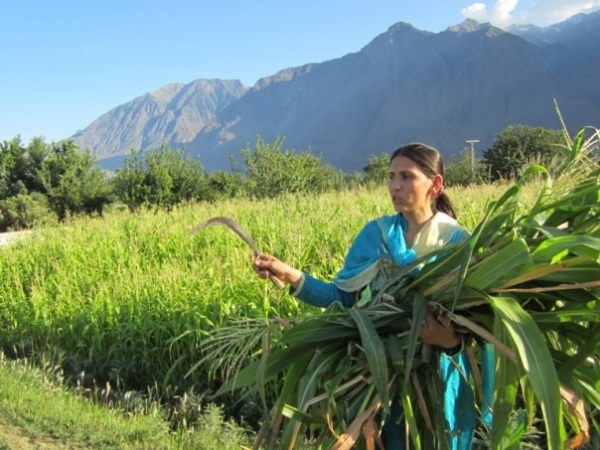The importance of partnerships for scaling up sustainability

Last December I attended an annual event of the Southern Agricultural Growth Corridor of Tanzania (SAGCOT) initiative - described as an ‘inclusive, multi-stakeholder partnership to rapidly develop the region’s agricultural potential’. IUCN works with the SAGCOT Centre in the context of a larger continental project we’re leading called SUSTAIN-Africa, which aims to use partnerships to ensure that investments into growth corridors include solutions for the sustainability of water, land and ecosystems that are socially inclusive and build resilience to climate change.
SAGCOT’s Annual Forum brings together a remarkable number of public, civil society and private sector partner organisations (90 as of November 2015), ranging from national to local level government agencies, environmental and social non-governmental organisations, international development agencies, research organisations, foundations, farmer cooperatives, industry associations and businesses. This year, the Forum included a field trip to the SAGCOT region – where we visited several agricultural value chains, which included smallholder and medium to large farms, crop distribution centres, and industrial processing facilities.
During the field trip we explored the sustainability challenges faced by farmers, including lack of inclusion and agricultural support for smallholder farmers, poverty, water scarcity, climate variability, and declining ecosystem services (defined as the benefits people obtain from ecosystems).
These agricultural value chains all sit within mosaic landscapes of multiple uses. Typically they are farmed fields with a variety of crops (including some agroforestry systems, and some forestry plantations in higher altitudes) interspersed with natural habitats, such as wetlands, rivers, riparian areas, savannah, and natural forests in the higher altitudes. Legally protected areas in the vicinity conserve important biodiversity values, and include Ruaha and UdzungwaNational Parks, and the Ramsar-designated Kilombero Valley Floodplain.
In the field I witnessed the impacts and tremendous potential of a number of diverse partnerships being convened to address challenges and realize opportunities for sustainability, together. From partnerships for environmental protection to smallholder livelihood improvement, involving a range of public, civil society and private sector actors, each actor brings complementary expertise and experience needed for implementing sustainable solutions in specific circumstances. The shared experiences, knowledge, tools and technologies for more sustainable forms of land management and livelihood development were all part of those conversations in the field, amongst this diverse network brought together over the past five years by the SAGCOT Centre.
While the positive social and environmental impacts of these partnerships in some of the farms and areas we visited are evident (e.g. better pesticide management from improved extension services, more efficient irrigation systems, improved access to markets), at the larger scale of the growth corridor, evidence shows that biodiversity loss, water scarcity, and climate change are still serious threats, along with persistent poverty. I think what is still missing is sustainability at the scale at which nature works best: across large landscapes or watersheds, where ecological boundaries matter more than political ones. And, these threats and poverty need to be addressed urgently.
It struck me, at the scale of landscapes and watersheds, nature provides a diverse range of ecosystem services, while at the scale of farms and villages, humanity provides a diverse range of services which complement nature’s role to support agricultural production. However, unsustainable development manifesting itself at large scales - from direct, indirect and cumulative impacts - is putting the ecological integrity of entire landscapes and watersheds at high risk. It is at this scale now that we need to be working.
At the Julius Nyere Convention Centre in Dar es Salaam, where the Forum ended with an event reflecting on the field visit and the year’s activities among SAGCOT partners, the understanding of the scale and urgency was palpable. In addition to the ambitious targets agreed to by partners for sustained economic growth in the region, participants acknowledged there must be equally ambitious and specific targets for ensuring positive impacts for people and nature at larger scales.
I think the only way to achieve this scale, at a pace fast enough, is through facilitating partnerships for action between public, civil society and private sectors – something IUCN does well. But it’s also time for the different sectors to begin challenging each other to implement solutions together.
Indeed, the UN’s recently launched Sustainable Development Goals(SDGs) indicate this, with SDG 17 ‘Partnerships for the Goals’ recognizing multi-stakeholder partnerships as important vehicles for mobilizing and sharing knowledge, expertise, technologies and financial resources to support the achievement of the sustainable development goals in all countries, particularly developing countries.
As my visit to the SAGCOT region confirmed, it really is time to unleash the full potential of partnerships for urgently scaling up targeted sustainable development from the ground up.
Deviah Aiama is a Programme Officer in IUCN’s Global Business and Biodiversity Programme. He works on promoting sustainable business approaches at the landscape-level in the SUSTAIN-Africa project, among other projects.
Source: IUCN

Facebook comments